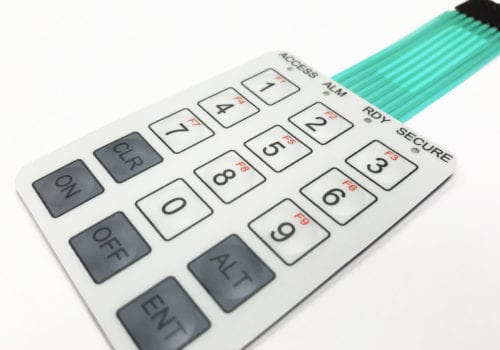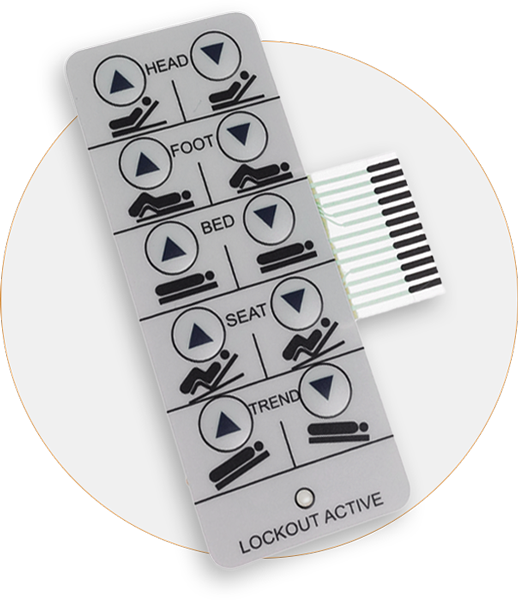Key Benefits of Using a Membrane Switch in Industrial Applications
Key Benefits of Using a Membrane Switch in Industrial Applications
Blog Article
Comprehending the Capability of Membrane Switches for Customer Interface Devices
The capability of membrane switches over represents a considerable advancement in individual interface layout, incorporating effectiveness with visual versatility. As markets significantly prioritize individual experience, recognizing the subtleties of membrane layer switch innovation comes to be essential.
What Are Membrane Buttons?
Membrane buttons are ingenious interface gadgets that assist in customer interaction with digital tools. These versatile components contain several layers, including a graphic overlay, spacer, and a published circuit layer. The style enables a seamless assimilation right into numerous digital tools, enhancing both the aesthetic and functional aspects of interface.
Membrane layer switches are frequently used in a variety of applications, from house devices to commercial machinery and medical tools. Their construction normally includes a thin profile, making them a perfect choice for compact styles. The tactile feedback given by these buttons can be engineered to meet specific customer choices, making certain efficient communication in between the customer and the tool.
Sturdiness is one more significant benefit of membrane buttons, as they are immune to dust, dampness, and chemicals, which enhances their lifespan sought after settings. Furthermore, these buttons can be personalized in terms of shape, size, and graphic layout, permitting branding and user-specific attributes. Generally, membrane switches over represent a practical remedy for enhancing individual experience in electronic tools, integrating functionality with visual appeal in an efficient manner.
Just How Membrane Switches Over Work
Operating on a straightforward concept, membrane layer switches make use of a layered building and construction to register customer input efficiently. Each button consists of multiple layers, consisting of a printed circuit layer, a spacer layer, and a leading visuals layer, which are developed to function together effortlessly. When a customer presses the top layer, it presses the spacer layer, bringing the conductive components of the circuit layer right into call with each other.
This get in touch with produces a shut circuit, signaling the gadget to implement a particular feature. The style enables numerous setups, consisting of responsive feedback, which can improve the individual experience by giving a physical feeling upon activation. The materials utilized in membrane layer switches typically consist of flexible substrates, such as polyester or polycarbonate, which make sure durability and strength versus wear and tear.

Key Advantages of Membrane Layer Buttons

Another substantial advantage is their compactness. Membrane layer switches are thin and light-weight, which allows manufacturers to conserve area in their tools without compromising functionality. This attribute is especially useful in applications where weight and quantity are essential factors to consider.
Additionally, membrane layer buttons are immune to dirt, moisture, and chemicals, improving their sturdiness. This resilience prolongs their life-span and decreases the demand for frequent replacements, causing cost financial savings over time.
Furthermore, the responsive responses provided by membrane layer switches can be enhanced to boost user interaction. They can consist of features such as check elevated switches or distinct clicks, improving functionality and customer experience.
Applications Throughout Industries
User interface gadgets making use of membrane buttons are widespread in a broad variety of sectors, showcasing their adaptability and capability. Membrane Switch. In the medical sector, membrane switches are important to tools such as diagnostic equipment and patient tracking systems, where their longevity and ease of cleaning are essential for preserving health standards. Similarly, in the auto industry, these switches are employed in dashboard controls and infotainment systems, offering a smooth and contemporary interface for users.
Furthermore, the consumer electronics sector gain from membrane layer buttons in appliances and handheld devices, where portable layout and straightforward interfaces boost customer experience. Industrial applications also leverage membrane layer switches over for control board in machinery and automation systems, emphasizing their effectiveness and resistance to rough atmospheres.
In the aerospace and protection sectors, membrane buttons are made use of in cabin controls and equipment, where reliability and efficiency under severe conditions are paramount. Additionally, the video gaming industry significantly includes membrane switches in controllers and gallery makers, adding to an engaging customer experience. In general, the convenience of membrane layer changes allows their extensive use throughout various markets, underscoring their value in contemporary user interface layout.
Future Trends in Membrane Switch Over Modern Technology

Additionally, using sophisticated products, such as polycarbonate and polyester anchor films, is expected to increase, giving enhanced sturdiness and resistance to environmental stress factors. These materials add to the total longevity of membrane switches, making them appropriate for harsher industrial applications.
In addition, the unification of clever technology, including IoT connectivity, will allow membrane switches to interact with various other gadgets and systems, promoting an extra interactive customer experience. This trend aligns with the growing need for clever tools throughout different fields, from medical care to customer electronic devices.
Finally, useful source modification choices are expected to broaden, enabling manufacturers to develop bespoke options customized to specific user demands and choices. These growths will certainly place membrane switches as vital parts in the advancement of interface innovation.
Final Thought
In verdict, membrane layer switches stand for a crucial advancement in individual interface modern technology, supplying a trusted and flexible option for varied electronic applications. As developments in product scientific research and touch sensing innovations continue, the capability and applicability of membrane buttons are anticipated to expand, reinforcing their significance in modern digital devices.
Report this page